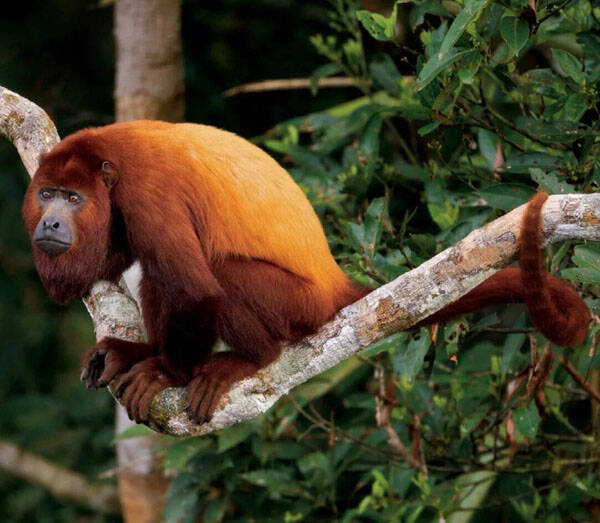Alouatta seniculus
IUCN
LCBasic Information
Scientific classification
- name:Alouatta seniculus
- Scientific Name:Alouatta seniculus
- Outline:Primates
- Family:H.monkeys
Vital signs
- length:46-72cm
- Weight:4.2-9kg
- lifetime:No verification information
Feature
Both males and females are dark reddish brown, but this fades with age.
Distribution and Habitat
Distributed in Venezuela, Colombia, Ecuador, Peru, Bolivia and the western part of the Amazon Basin in Brazil.
Appearance
The red howler monkey has some sexual dimorphism. Males are 49-72 cm long and females are 46-57 cm long. Males weigh 5.4-9 kg and females weigh 4.2-7 kg. They have a prehensile tail that is about 49-75 cm long. The tail is furry, but the very end is hairless, which makes it easier to grasp. Both males and females are dark reddish brown, but this fades with age. The face is furred and the nose is stubby.
The red howler monkey has a large jawbone. The foramen magnum is located very far back to allow room for the jawbone and hyoid bone. They have a large bony hood in their middle ear, which is different from other New World monkeys.
Red howlers are arboreal and prefer to be active during the day, spending much of their time in the forest canopy. They prefer to walk on all fours and rarely jump. Their tail provides additional support. Their second and third fingers are widely spaced, which is suitable for grasping trees.
Details
Red howler monkey (scientific name Alouatta seniculus) is a species of howler monkey in South America.

Red howler monkeys live in small groups of 3-9 individuals. They are polygamous. There is a male leader who leads the group to find food and defend it. Females in the group take care of the young. They are active during the day, especially when looking for another place to feed. Males will roar at dawn to make their presence known, which can be heard up to 5 kilometers away. This helps avoid fighting between groups and reduces the energy consumed by fighting. Since their diet is low in sugar, it is very important for them to conserve energy. Roaring can also help the distribution of the group, thereby reducing competition.
Red howler monkeys mainly eat leaves, but they also eat nuts, small animals, fruits, seeds and flowers. These foods provide enough sugar for growth and activity. Leaves are an important food, and they cannot go more than a week without eating leaves. Their teeth are designed to bite open leaves: narrow incisors help swallow leaves, and molars help chew food. Their stomach structure is also complex, and the hindgut and intestines also help digestion. The hindgut contains bacteria that digest leaves, and its volume accounts for one-third of the volume of the red howler monkey. Like other New World monkeys, the red howler monkey has 2 incisors, 1 canine, 3 premolars and 3 molars in each jaw.
The sex chromosome system is XXYY and XXXX. Due to the serious imbalance in the sex ratio, there will be fierce competition between male monkeys. Female monkeys will stick out their tongues to attract male monkeys for mating. If the male monkey does not respond, the female monkey will look for other male monkeys. The average gestation period is 190 days. The baby monkeys will stay with the mother monkey for 18-24 months. When the male monkey reaches sexual maturity, it will be squeezed out of the group. Male monkeys must invade other groups: kill the male monkey leader and his baby monkeys, in order to eliminate all potential competition. The survival rate of baby monkeys after male invasion is less than 25%.
Currently, the World Conservation Union lists the red howler monkey as an endangered species on the Red List.
Protect wild animals and stop eating game.
Maintaining ecological balance is everyone's responsibility!








